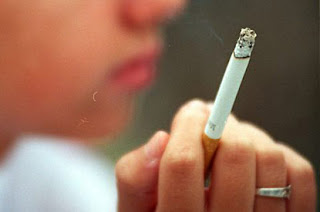
THE HEAD of secondary school teachers’ union OELMEK yesterday called for designated smoking areas in schools, after an indecisive circular from the Education Ministry failed to offer a proper solution.
In February, the Attorney-general’s office ruled that it was not against the law for teachers to smoke in the schoolyard.
The AG’s advice came after a circular letter by the ministry, calling on teachers “to faithfully follow the law’s provisions, according to which smoking is banned in all school areas, including offices, hallways, stairwells, toilets, yards and canteens”.
The ministry followed up with a second circular, informing teachers on the AG’s ruling and basically saying that it was not against the law to smoke in the schoolyard, but it was “wrong” to smoke in front of pupils.
But OELMEK head Demetris Taliadoros yesterday said the ministry’s second letter offered no solution to the problem. He said it felt like the ministry was “sermonising” to avoid revealing the real issue, which was lack of funds to create designated smoking areas in schools.
“We say it is indeed unacceptable for teachers to smoke on the pavement or schoolard in full view of the pupils,” said Taliadoros.
“But the 2010 smoking ban law says that in the workplace, workers have the right to request their employers build a special area for smokers,” he added. “OELMEK requested it and the ministry refused. We don’t know the reasons; maybe they aren’t just pedagogical and health-related, but have to do with the fact that we would have to install special airing systems and so on, so it may also be down to economic reasons.”
Taliadoros said the ministry was using the moral aspect as an excuse to avoid creating the areas. “This is the obligation of the employer, who in this case is the education ministry.”
He added: “I feel the majority of the circular letter’s contents were of a sermonising nature, saying ‘it is bad to smoke so you won’t smoke’. I don’t smoke and don’t like the smell of smoke, but I understand the reactions of those who do”.
According to Taliadoros, before the ban, teachers had two meeting rooms, one of which was for smokers, within the school buildings. He said he didn’t remember there being any problems with smoke drifting into the rest of the building.
“These are big rooms with many windows, so I feel this wasn’t an issue,” he said. “Is it better to see smokers in the yard smoking? It is better they are restricted away. This is where the pedagogical angle comes in; they shouldn’t be seen by the pupils.”
The AG ruled that secondary school yards were exempt from the smoking ban, as not only did the law not ban it, it wasn’t banned by school regulations either.
“Regarding the pedagogical side of the smoking ban for workers, inside as well as outside an educational institution, I am of the opinion that any circular directive should be supported by the relevant educational law, the violation of which is a criminal offence,” said the AG.
In its second letter, the ministry told teachers that health lessons on the dangers of smoking were not enough, if teachers failed to lead by example. “Teachers can’t teach about a society free of smoke in the classroom if they can’t see their school as a public area free of smoke,” said the ministry.
Furthermore, it added, Cyprus’ teen smokers’ figures are much higher than most other EU states, with the average age of first-time smokers being 14. “The absence of smoke within the school area and areas where youths meet, considerably contributes to reducing the number of teenage smokers.”
The ministry also pointed out that the majority of secondary school teachers were in favour of the full ban.
EFI Gavriel has two teenage sons. She believes her sons are more influenced by their schoolmates and friends than their teachers, though she is not 100 per cent okay with teachers smoking in the yard.
“In my eldest son’s school, the headmaster himself smokes and plays backgammon in the yard,” said Gavriel. “I don’t think the pupils are affected by the teachers smoking, but their friends and schoolmates. But it definitely doesn’t help to see their teachers, some children look up to them as role models.”
A smoker herself, Gavriel admits she is against the full ban. “I think teachers should maybe have a designated area.”
She added, “As for my youngest; he sees the sixth and seventh graders smoking and is affected more by that. He has never mentioned his teachers smoking.”
Maria Avraam, however, is not as accepting. “I think it is an outright disgrace for teachers to smoke in the schoolyard, right in front of their impressionable pupils. I admit they can be more influenced by their friends, but do we really need to worry about the teachers now as well?”
You smoke cigarettes? Than
buy marlboro cigarettes online for cheap price.






